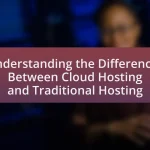The article focuses on the key features to consider when selecting a managed hosting provider, emphasizing the importance of robust security measures, reliable uptime guarantees, comprehensive customer support, scalability options, and performance optimization tools. It discusses how these features impact website performance, including speed and reliability, and outlines essential performance metrics such as uptime, response time, and load time. Additionally, the article highlights the significance of customer support, security protocols, backup and recovery options, and scalability in relation to business growth and budget considerations. Best practices for evaluating potential providers and critical questions to ask during the selection process are also provided to assist businesses in making informed decisions.
What are the Key Features to Look for in a Managed Hosting Provider?
Key features to look for in a managed hosting provider include robust security measures, reliable uptime guarantees, comprehensive customer support, scalability options, and performance optimization tools. Security measures such as firewalls, DDoS protection, and regular backups are essential to safeguard data. Reliable uptime guarantees, typically above 99.9%, ensure that websites remain accessible. Comprehensive customer support, available 24/7, is crucial for resolving issues promptly. Scalability options allow businesses to adjust resources as needed, accommodating growth. Performance optimization tools, including caching and content delivery networks (CDNs), enhance website speed and efficiency. These features collectively contribute to a dependable and efficient managed hosting experience.
How do these features impact your website’s performance?
The features of a managed hosting provider significantly enhance a website’s performance by optimizing speed, reliability, and security. For instance, features such as content delivery networks (CDNs) reduce latency by distributing content closer to users, resulting in faster load times. Additionally, automatic backups and updates ensure that the website remains secure and operational, minimizing downtime. Research indicates that websites with optimized hosting environments can load up to 50% faster, which directly correlates with improved user experience and higher search engine rankings.
What specific performance metrics should you consider?
When evaluating a managed hosting provider, consider specific performance metrics such as uptime, response time, and load time. Uptime measures the percentage of time the server is operational, with a standard target of 99.9% or higher, indicating reliability. Response time assesses how quickly the server responds to requests, ideally under 200 milliseconds for optimal user experience. Load time refers to the duration it takes for a webpage to fully render, with a target of under three seconds to minimize user drop-off. These metrics are critical as they directly impact user satisfaction and site performance, influencing overall business success.
How do these features enhance website speed and reliability?
Features such as content delivery networks (CDNs), optimized server configurations, and automatic scaling enhance website speed and reliability by reducing latency, improving load times, and ensuring consistent performance under varying traffic conditions. CDNs distribute content across multiple servers globally, allowing users to access data from the nearest location, which significantly decreases loading times. Optimized server configurations, including caching and resource allocation, streamline data processing, further enhancing speed. Automatic scaling adjusts resources in real-time based on traffic demands, preventing downtime during peak usage. These features collectively ensure that websites load quickly and remain accessible, even during high traffic periods, which is crucial for user experience and retention.
Why is customer support crucial in a managed hosting provider?
Customer support is crucial in a managed hosting provider because it directly impacts the reliability and performance of hosted services. Effective customer support ensures that technical issues are resolved quickly, minimizing downtime and maintaining business continuity. According to a study by Zendesk, 67% of customers have hung up the phone out of frustration while waiting for support, highlighting the importance of responsive and knowledgeable assistance. Additionally, managed hosting environments often involve complex configurations and integrations, making expert support essential for optimizing performance and security. Thus, robust customer support is a key feature that enhances user experience and operational efficiency in managed hosting services.
What types of customer support options should be available?
Customer support options that should be available include live chat, email support, phone support, and a comprehensive knowledge base. Live chat provides immediate assistance, allowing customers to resolve issues quickly, while email support offers a more detailed communication method for complex inquiries. Phone support enables direct interaction with support representatives, which can be crucial for urgent problems. A knowledge base serves as a self-service resource, empowering customers to find solutions independently. These options are essential as they cater to different customer preferences and needs, ensuring effective and efficient support.
How does response time affect your experience with a hosting provider?
Response time significantly impacts your experience with a hosting provider by influencing website performance and user satisfaction. A faster response time leads to quicker loading pages, which enhances user engagement and reduces bounce rates; studies show that a one-second delay in page load time can lead to a 7% reduction in conversions. Additionally, responsive customer support, characterized by low response times, ensures that issues are resolved promptly, further improving overall service satisfaction. Therefore, both server response time and support response time are critical metrics that directly affect user experience with a hosting provider.
What Security Features Should You Expect from a Managed Hosting Provider?
A managed hosting provider should offer robust security features, including firewalls, DDoS protection, regular security audits, and data encryption. Firewalls protect against unauthorized access, while DDoS protection mitigates the impact of distributed denial-of-service attacks, ensuring uptime and reliability. Regular security audits help identify vulnerabilities, and data encryption safeguards sensitive information during transmission and storage. According to a 2021 report by Cybersecurity Ventures, global cybercrime costs are projected to reach $10.5 trillion annually by 2025, underscoring the importance of these security measures in managed hosting environments.
How do security features protect your data?
Security features protect your data by implementing measures such as encryption, access controls, and regular security audits. Encryption secures data by converting it into a coded format that can only be read by authorized users, ensuring confidentiality during transmission and storage. Access controls restrict data access to authorized personnel, minimizing the risk of unauthorized data breaches. Regular security audits identify vulnerabilities and ensure compliance with security standards, further safeguarding data integrity. These combined measures significantly reduce the likelihood of data loss or theft, as evidenced by studies showing that organizations with robust security features experience fewer data breaches.
What are the essential security protocols to look for?
The essential security protocols to look for in a managed hosting provider include SSL/TLS encryption, firewalls, intrusion detection systems (IDS), and regular security audits. SSL/TLS encryption ensures that data transmitted between users and the server is secure, protecting sensitive information from interception. Firewalls act as barriers to unauthorized access, while intrusion detection systems monitor network traffic for suspicious activity. Regular security audits help identify vulnerabilities and ensure compliance with industry standards, enhancing overall security posture. These protocols collectively contribute to a robust security framework essential for protecting data and maintaining trust.
How does the provider handle data breaches and vulnerabilities?
The provider handles data breaches and vulnerabilities by implementing a comprehensive incident response plan that includes immediate detection, containment, and remediation of security incidents. This plan typically involves continuous monitoring of systems for unusual activity, regular security audits, and vulnerability assessments to identify potential weaknesses. Additionally, the provider often employs encryption, access controls, and employee training to mitigate risks. For instance, according to the 2021 Verizon Data Breach Investigations Report, organizations that have a formal incident response plan are 50% more likely to contain breaches within a day.
What backup and recovery options are important in managed hosting?
In managed hosting, important backup and recovery options include automated backups, offsite storage, and rapid recovery solutions. Automated backups ensure that data is regularly saved without manual intervention, minimizing the risk of data loss. Offsite storage protects backups from local disasters, providing an additional layer of security. Rapid recovery solutions enable quick restoration of data, reducing downtime and maintaining business continuity. These features are essential for safeguarding data integrity and ensuring operational resilience in managed hosting environments.
How often should backups be performed?
Backups should be performed at least daily to ensure data integrity and minimize potential loss. Regular daily backups help capture changes and new data, providing a reliable recovery point. According to a study by the Ponemon Institute, 70% of organizations that experience data loss do not recover fully, highlighting the importance of frequent backups in managed hosting environments.
What recovery options should be available in case of data loss?
In case of data loss, recovery options should include regular automated backups, real-time data replication, and a disaster recovery plan. Regular automated backups ensure that data is consistently saved at scheduled intervals, allowing for restoration to the most recent state. Real-time data replication provides an immediate copy of data to a secondary location, minimizing downtime and data loss. A disaster recovery plan outlines the steps to restore systems and data in the event of a catastrophic failure, ensuring business continuity. These options are critical for managed hosting providers to safeguard client data effectively.
What Scalability Options Should You Consider in a Managed Hosting Provider?
When selecting a managed hosting provider, consider scalability options such as vertical scaling, horizontal scaling, and auto-scaling capabilities. Vertical scaling allows you to increase resources like CPU and RAM on existing servers, which is beneficial for applications that require more power without changing the architecture. Horizontal scaling involves adding more servers to distribute the load, enhancing performance and reliability, especially for web applications experiencing high traffic. Auto-scaling automatically adjusts resources based on real-time demand, ensuring optimal performance and cost-efficiency. These scalability options are crucial for accommodating growth and maintaining service quality as user demands fluctuate.
How does scalability affect your business growth?
Scalability directly impacts business growth by enabling companies to efficiently adjust their resources in response to increasing demand. When a business can scale its operations, it can accommodate more customers, enhance service delivery, and ultimately increase revenue without a proportional increase in costs. For instance, a study by Gartner indicates that organizations that effectively implement scalable solutions can achieve up to 30% faster growth compared to those that do not. This ability to adapt quickly to market changes and customer needs is crucial for maintaining a competitive edge and fostering long-term success.
What types of scalability options should be offered?
Managed hosting providers should offer vertical and horizontal scalability options. Vertical scalability allows for increasing resources such as CPU, RAM, and storage within a single server, which is beneficial for applications that require more power without changing the architecture. Horizontal scalability involves adding more servers to distribute the load, enhancing performance and reliability for applications that can operate across multiple instances. Both options are essential as they enable businesses to adapt to varying workloads efficiently, ensuring optimal performance and cost-effectiveness.
How can you assess the scalability of a hosting provider?
To assess the scalability of a hosting provider, evaluate their ability to accommodate increasing traffic and resource demands without compromising performance. Key indicators include the provider’s infrastructure flexibility, such as the availability of cloud-based solutions that allow for on-demand resource allocation, and their track record of handling traffic spikes, evidenced by case studies or client testimonials. Additionally, review their service level agreements (SLAs) for guarantees on uptime and performance during scaling events, as well as their support for various scaling methods, such as vertical and horizontal scaling options.
What are the pricing models for managed hosting services?
Managed hosting services typically utilize three primary pricing models: flat-rate pricing, pay-as-you-go pricing, and tiered pricing. Flat-rate pricing involves a fixed monthly fee for a defined set of services, making budgeting straightforward for businesses. Pay-as-you-go pricing charges clients based on actual resource usage, which can be cost-effective for those with fluctuating demands. Tiered pricing offers different service levels at varying price points, allowing customers to choose a plan that best fits their needs and budget. These models cater to diverse business requirements and financial strategies, ensuring flexibility and scalability in managed hosting solutions.
How do different pricing structures impact your budget?
Different pricing structures significantly impact your budget by determining the overall cost and resource allocation for managed hosting services. For instance, a flat-rate pricing model allows for predictable monthly expenses, making it easier to budget without unexpected costs. In contrast, usage-based pricing can lead to fluctuating expenses, which may strain a budget if resource consumption exceeds estimates. According to a study by Gartner, organizations that adopt predictable pricing models can reduce their IT spending by up to 20% compared to those using variable pricing structures. This demonstrates that the choice of pricing structure directly influences financial planning and resource management in managed hosting.
What hidden costs should you be aware of?
Hidden costs in managed hosting can include overage charges for bandwidth, fees for additional storage, and costs associated with technical support beyond the included services. Bandwidth overage fees can arise when usage exceeds the plan limits, often leading to unexpected charges. Additional storage fees may apply if the initial storage allocation is insufficient for your needs, which is common in scalable hosting solutions. Furthermore, many providers charge extra for premium support services or advanced features that are not included in the base plan, which can significantly increase overall expenses. Understanding these potential hidden costs is crucial for budgeting effectively when selecting a managed hosting provider.
What are the best practices for choosing a managed hosting provider?
The best practices for choosing a managed hosting provider include evaluating their performance, support, security, scalability, and pricing. Performance is critical; providers should offer high uptime guarantees, typically above 99.9%, and fast load times, which can significantly impact user experience and SEO rankings. Support is essential; look for 24/7 customer service with multiple contact methods, as timely assistance can resolve issues quickly. Security features, such as regular backups, SSL certificates, and DDoS protection, are vital to safeguard data. Scalability is important for future growth; the provider should offer flexible plans that can accommodate increasing traffic and resource needs. Finally, pricing should be transparent with no hidden fees, allowing for a clear understanding of costs associated with the services provided. These practices ensure that the chosen provider aligns with business needs and can support long-term goals.
How can you evaluate potential providers effectively?
To evaluate potential providers effectively, assess their service offerings, reliability, and customer support. Start by reviewing their service level agreements (SLAs) to understand uptime guarantees and response times. Analyze customer reviews and case studies to gauge reliability and performance metrics, such as average downtime and speed. Additionally, evaluate the quality of customer support by testing response times through inquiries and examining available support channels, such as live chat, email, and phone support. This structured approach ensures that you select a provider that meets your specific needs and expectations.
What questions should you ask during the selection process?
During the selection process for a managed hosting provider, you should ask questions that assess their reliability, support, and scalability. Key questions include:
- What is your uptime guarantee, and how do you ensure it?
- What types of support do you offer, and what are your response times?
- Can you provide details on your security measures and compliance standards?
- How do you handle backups and disaster recovery?
- What is your pricing structure, and are there any hidden fees?
- How easily can I scale my resources as my business grows?
These questions are essential to evaluate the provider’s capabilities and ensure they align with your business needs.










